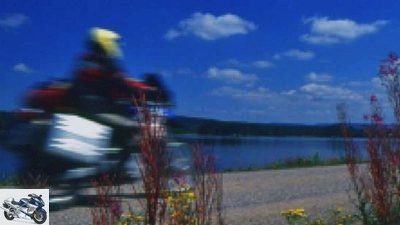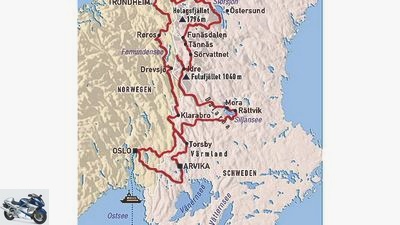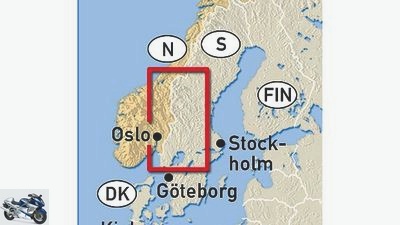Table of contents

Deleker
to travel
Central Sweden
Central Sweden
Where does the north begin?
For some southern Germans, the Main already sets the limit, others only get real Nordic feelings shortly before the Cape. What is the real north? Looking for orientation in central Sweden.
Joachim Deleker
07/05/2007
The silence cannot be ignored. No car, no splashing water, no wind. Nothing. The small lake on the Swedish-Norwegian border, where we pitched our tents, shines as smooth as a mirror. The landscape seems untouched, round, wooded mountain tops rise all around. There is a spicy scent of pine in the air. Even the few gray-purple clouds stand motionless in the glowing midnight sky. Andreas and I hardly exchange a word. And if so, then as quiet as a whisper. As if we could disturb the silence. The only ones who don’t abide by the silent pact are a couple of mosquitoes. Every now and then their annoying buzz reaches the ear, comes closer, gets louder, until a quick, routine hand movement ensures silence again.
We have arrived. Feel the far north. Would like to experience it, up here in the central Swedish provinces of Varmland, Dalarna and Jamtland. Instead of the boring European roads to Lapland and the North Cape, we want to roam the wilderness on the smallest possible paths. Always on the lookout for moose and the vastness and solitude of the mountains. Using a rough compass heading northeast, we try to find the right paths in the tangle of many slopes. Sometimes signs help, but often enough only a good sense of direction. For hours we dust our enduros over yellow-brown dirt roads, seeing nothing but spruce and pine forests, gentle mountains, countless lakes and ponds. A landscape where elk and beaver say good night and at most an ancient, light blue humpback Volvo rumbles towards you. Otherwise nothing, for almost 100 kilometers.
It’s just too bad that at some point we won’t have the slightest idea where we are. The map does not show many of the small paths. Finally we come across a tar road with two signposts. Left to Norra soldering, right to Sodra soldering. The small lake is called Lotsjon. It takes a while to locate this location on the map. We turn right and solder over the fast road to the east, past the mountains Rullknolen and Kamknolen.
Every now and then clearings with typical Swedish wooden houses. In yellow or white, but mostly red and in any case very cozy. Complemented by a perfectly manicured lawn and a flagpole with a blaugelb fluttering national cloth. Pure Sweden idyll. On summer mornings like this one, blue and white exhaust fumes sometimes permeate the towns, and the screeching of two-stroke lawnmowers cuts through the silence. Sweden mows the lawn. In the afternoon, calm usually returns. Tables and chairs are put in front of the house on the freshly styled lawn, the family makes themselves comfortable with coffee and cake and watches life on the street. It would never occur to anyone to sit behind the house.
If this scenery already looks like from the Sweden advertisement, the villages on Lake Siljan are adding one more thing. The rustic wooden houses, completely in traditional Falun red, with snow-white window frames and lush flower boxes. Feels like an open-air museum.
In keeping with this, an unusually large number of vintage cars stroll through the streets. You come directly from the “Classic Car Week” from Rattvik on the nearby Lake Siljan.
Apparently a 1960s America party is going on there. Giant American road cruisers with their eight-cylinder big blocks are constantly pounding up and down the main street. See and be seen. Gel shimmers in the quiff, and the cassette recorder vibrates Elvis songs at maximum volume into orbit. The sheriffs lean relaxed against their BMWs, untouched by the traffic chaos that the oldies spark. Not even the burnout that a flaming red Ford Mustang screams onto the asphalt disturbs her. Swedes know how to live.
We too are slowly becoming part of it, sitting for hours in the warm sun in front of a cafe, marveling at the Amish sledge and not feeling the slightest urge to continue driving. Until the closing time of the local supermarket forces us to leave. We don’t have dinner yet. Shopping in Sweden is fun, at least if you don’t understand Swedish. We read out the inscriptions, try to translate. The favorite is a glass of “Bringebærsyltetoy med mer bær”, which we identify as Norwegian raspberry jam. The thing rubs off. We will soon be replacing “Nesquik”, the synonym for cocoa we are used to from our childhood, with the “Ogon Blink” brand and renaming the idle of our motorcycles “Gångveg”. Which means walking, but sounds a lot more like “no gear”, that is, idling.
We could have saved ourselves the purchase. Because as we park the motorbikes on the campsite, neighbor Anders, a lively mid-sixties from Stockholm, has just returned from fishing with two big graylings. And explains that he couldn’t possibly get rid of it on his own. “So you fire up the stove and I’ll take the guys off in the meantime.” A clear instruction in rudimentary German that many older Swedes can still speak. We don’t even try to contradict. Not even when Anders conjured up two bottles of Italian white wine from his Saab and made it clear that fish would be unthinkable without wine. Even if almost unaffordable in Sweden.

Map: Maucher
Time: 2 weeks – distance: 2000 km
The next morning, Anders is already fishing again. We load the motorcycles and head north-west. The hills are slowly increasing in size, and when we see the Fulufjall with its 1000 meter peaks, the landscape has a distinctly more Nordic character. It has become more lonely, the trees no longer reach the same height as in the south, and bare rock massifs give the scenery something big and wild. Ripe blueberries beckon next to the slopes. On the spur of the moment, we pick a bag full. Blueberry pancakes should also be made on the camping stove.
Down in the valley, the Vasterdalsalv is looking for its long way to the Baltic Sea. Right on the river is a tiny campsite with rickety tables and benches, two taps and a loo that has seen better days. Instead, there is forest all around and a clear view of the Fulufjallet to the west. Suddenly a splash in the water:
a beaver! He paddles down the river with great enthusiasm, ignoring us. We fire up the stove, mix the blueberries into the pancake batter and are happy about the great space. Until Andreas suddenly derailed his facial features and he almost dropped the pan. He stares into the forest in amazement. “Moose!” Indeed. Barely 30 meters away is a cow elk with two calves. She calmly watches us baking, while her boys patter back and forth, visibly nervous. Have never seen motorcyclists before. We dare not move, we stare back as if spellbound. At some point the single mother turns around, bored, and trots back into the forest with her small family. Later I excitedly tell the campsite manager about the encounter. “Yes, they come over often. After all, there are more moose than people here in the north of Dalarna. And there are brown bears too. But thank God they rarely come to visit. ”Before she can continue, a sharp flash of lightning interrupts our chat, and the thunder follows almost immediately.
Half the night the elements fire from all cylinders. It has long been light again when the thunderstorm finally leaves. And took away the heat of the last few days. 28 degrees were anything but normal for central Sweden. A few white clouds sail north in the cleanly cleaned sky. The air is crystal clear. We too are heading north.
Behind the small town of Idre, the far north finally seems to begin. The slope is slowly gaining height and the forest is getting thinner and thinner until it finally gives way to bushes and grasses above the 800 meter mark. Sweden’s highest pass lies ahead of us. At 975 meters, not exactly a record, but already beyond the tree line. The road cuts almost dead straight through the gray-green tundra. Every now and then a few reindeer or a small pond in which the blue sky is reflected. Far in front of us, gently rounded, but at 1,800 meters huge mountains dominate the horizon. A black shower cloud rolls over the bare fells. Far back I see the light from Andreas ’Africa Twin glimmering in my plume of dust. Width almost like in Alaska.
The mighty mountain range in the north forces the road to take a long detour to the east. Not a single path traverses the wilderness of the fell. We land at Storsjon, roughly translated as the big lake. A fitting name, as the 70-kilometer-long expanse of water looks like a small sea. There is not much to see, the attraction is hidden in its waters: the Storsjon monster. More than 200 people want to have seen the snake-shaped beast. It is said to be 14 meters long and shimmer either black, green or gray-red. It goes without saying that the monster comes from a famous family: it is Nessie’s cousin. Like its relative in Loch Ness, the Storsjon monster was hunted down mercilessly. First they tried a huge fishing iron with a live pig as bait. Then a Norwegian whaler was hired. But the monster was too smart to fall for such tricks. So that it was unceremoniously placed under nature protection. If you want, you can go on a monster safari with an old steamboat. Tremendous business.
Much more exciting than the supposed beast is the landscape along the E 14 and its climax is the mightiest waterfall in the country, the roaring, 38-meter-high Tannfors. For us it marks the northernmost point of the journey. The
We have passed the 63rd degree of latitude and are barely 350 kilometers from the Arctic Circle. The E 14 takes us to Norway, and there we try to follow the shortest possible paths along the border southwards.
After a while we reach Røros. And we like it immediately. An ensemble of lovingly restored wooden houses in black, yellow, red and white. Some up to 350 years old.
Unlike most other cities, the lively old mining town was never destroyed by fire. And declared a World Heritage Site by UNESCO. South of Røros we dive again into the endless forests and their maze of small slopes, imperceptibly cross the border to Sweden again, even find our lake again, on the shore of which we stayed ten days ago and felt the breath of the north for the first time. Nothing has changed at all since then. Even the clouds seem to be the same, glowing intensely gray-violet again against the glowing midnight sky. And the mosquitoes who want to ruin our quiet evening haven’t learned anything either. Carelessly, they buzz around us until a quick hand movement ensures calm. In favor of the incomparable silence that is so typical of the far north.
Info
If you are looking for the far north, you don’t have to go to Cape. In the central Swedish provinces of Varmland, Dalarna and Jamtland you will find everything that characterizes the north: lonely forests through which countless slopes wind their way, impressive mountains, endless expanses and ?? with a little bit of luck ?? Moose.

Map: Maucher
GETTING THERE
There are several options for the passage to Sweden. For example, every day by Color-Line night ferry from Kiel to Oslo, a good starting point for this tour. Tickets for one person with a motorcycle cost from 190 euros. More information from Color-Line in Kiel, phone 0431/7300300 or at www.colorline.com. The Stena-Line also starts from Kiel to Gothenburg, Sweden, but this extends the journey to Varmland and Dalarna. In 2007, the TT-Line, in cooperation with the Scandinavian specialist Feelgoodreisen, is also offering motorcycle tours through Sweden. More at www.TTLine.com.
TRAVEL TIME
The best conditions can be expected between the end of May and the end of August. In June and July it only gets dark for a short time this far north. The weather is usually much better than in the Norwegian Fiordland, as the clouds streaming in from the west are already raining down in the mountains of Norway, giving Sweden significantly more hours of sunshine. The daytime temperatures reach 15 to 25 degrees in July, night frost is to be expected above 1000 meters above sea level.
OVERNIGHT STAY
Sweden offers travelers a dense network of campsites. An overnight stay per tent and person costs between five and ten euros. Typical are »Stugas«, small, rustic wooden huts with cooking facilities and bunk beds for two to six people, which are rented out on campsites as well as privately. In rainy weather, motorcycle travelers in particular will find ideal shelter here to wait for better days. Varying in size and features, they cost between 30 and 60 euros. The further north and the deeper one moves in the woods away from the villages, the less often
but become the official campsites. In contrast to the livelier southern Sweden, there are enough places in the middle of the country for free camping, often in a beautiful location by a river or lake. Legitimized by the everyone’s right valid throughout Scandinavia, which allows travelers to spend the night in the wild – except on recognizable private property and in protected areas. However, you have to strictly refrain from campfires in summer due to the high risk of forest fires. Guest houses and hotels are rather few and far between and are almost exclusively located in localities.
Their price level is slightly higher than in Germany.
FINANCE
Although Sweden is part of the EU, it continues to use the Swedish krona as its currency. For one euro there is currently 9.4 SEK. The easiest way to replenish money is with an EC or credit card at ATMs that can be found all over the country. Even if Sweden and especially Norway are among the most expensive countries in Europe, a vacation there does not necessarily have to devour a fortune. Sure, those who stay in hotels and eat in restaurants could quickly be broke. Those who, on the other hand, rely on the uncomplicated and attractive camping and self-catering options are no more expensive in Sweden than in Italy or France.
INFORMATION
There is very extensive information in the Sweden advertising, Lilien-
strabe 19, 20095 Hamburg, phone 040 / 3255-1355, fax -1333, good network information
at www.schweden-urlaub.de.
LITERATURE
On the way, the Sweden travel guide from Velbinger Verlag has proven itself, 544 pages long and 24.80 euros expensive. The Swedish Esselte sheets number 3 and 5 on a scale of 1: 300,000, which are available locally, are recommended as maps. The maps from Kummerly are even more detailed
& Frey in 1: 250000 for 11.90 euros. Take numbers 2, 4 and 5 with you for this trip. Nevertheless, orientation is not always easy, as many of the small paths are not shown on these maps either.
Related articles
-
Motorcycle tour – border between Sweden and Norway
Deleker 22nd pictures Jo Deleker 1/22 On all fells – on the move in Sweden. Jo Deleker 2/22 Swedish moments: curious moose. Jo Deleker 3/22 Swedish…
-
to travel Southern sweden Southern sweden Bullerby is everywhere Anyone looking for a nice rhyme for life should get to know Sweden. There is almost…
-
to travel Sweden Sweden Gosh You quickly feel at home in the south of Sweden: winding gravel roads, red wooden houses, endless forest and 5000 lakes – a…
-
Photos: Obert to travel South and Central Asia South and Central Asia Around the roof of the world It’s hard to believe, but the idea came spontaneously…
-
MOTORCYCLE tour tip – Central Black Forest tour
Tour tips Exclusive motorcycle tours for children to follow Presented by Dirk Schafer to travel MOTORCYCLE tour tip – Central Black Forest tour…
-
With the motorcycle in Sweden – Lapland
Lundgren to travel With the motorcycle in Sweden – Lapland The gravel paradise for enduros With the motorcycle in Sweden – Lapland Sweden is a sparsely…
-
MOTORCYCLE tour tip – Central Alb day tour
Tour tips Exclusive motorcycle tours for children to follow Presented by Markus Biebricher to travel MOTORCYCLE tour tip – Central Alb day tour…
-
Ed motorcycle museum in Sweden
Thomas Schmieder to travel Ed motorcycle museum in Sweden Ed motorcycle museum in Sweden Provincial surprise Content of Branding is taught at the Ed…
-
to travel Central America Central America At the limit Drive once from Mexico to Panama, over that almost ridiculously small land bridge between the…
-
BMW R18 conversion by UCC from Sweden
BMW Motorrad Nordic 7th pictures BMW Motorrad Nordic 1/7 Unique Custom Cycles is converting an R18 on behalf of BMW Motorrad. BMW Motorrad Nordic 2/7 The…